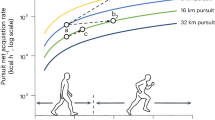Abstract
EVOLUTIONARYstudies are hampered by a lack of experimental ways in which to test past events such as the origination of aposematism1–7, whereby unpalatable or poisonous prey signal their unprofitability, often by being warningly coloured. Inexperienced predators do learn to avoid unpalatable prey as a result of such signals8–10, but in addition there may be an inherited cautiousness about attacking when common or conspicuous warning signals are evident11–16. As current predators are not naive in the evolutionary sense, it is still not resolved3–7,17,18 whether aposematism originated only in aggregations of prey19,20 or among solitary prey as well21–23. Here we explore this controversy in evolutionarily naive predators by creating a novel world with warning signals not found in the environment. Initially, the aggregation of prey favoured the warning signals supporting Fisher's view24 of kin aggregations as the evolutionary starting point of aposematism. However, once predators had experienced warning signals, pre-existing avoidance seemed to facilitate evolution of Müllerian mimicry complexes25 with similar types of signals even among solitary prey.
This is a preview of subscription content, access via your institution
Access options
Subscribe to this journal
Receive 51 print issues and online access
$199.00 per year
only $3.90 per issue
Buy this article
- Purchase on Springer Link
- Instant access to full article PDF
Prices may be subject to local taxes which are calculated during checkout
Similar content being viewed by others
References
Poulton, E. B. The Colours of Animals: Their Meaning and Use (Kegan Paul, Trench, Trubner, London, 1890).
Edmunds, M. Defence in Animals: A Survey of Anti-predator Defences (Longman, Harlow, Essex, 1974).
Guilford, T. Am. Nat. 131, S7–S21 (1988).
Guilford, T. in Insect Defence: Adaptive Mechanisms and Strategies of Prey and Predators (eds Evans, D. L. & Schmidt, J. O.) 23–61 (State Univ. of New York Press, NY, 1990).
Mallet, J. & Singer, M. C. Biol. J. Linn. Soc. 32, 337–350 (1987).
Endler, J. A. Phil. Trans. R. Soc. Lond. B 319, 505–523 (1988).
Endler, J. A. in Behavioural Ecology: An Evolutionary Approach 3rd edn (eds Krebs, J. R. & Davies, N. B.) 169–196 (Blackwell, Oxford, 1991).
Gittleman, J. L. & Harvey, P. H. Nature 286, 149–150 (1980).
Roper, T. J. & Wistow, R. Q. J. exp. Psychol. 38, 141–149 (1986).
Roper, T. J. & Redston, S. Anim. Behav. 35, 739–747 (1987).
Rubinoff, I. & Kropach, C. Nature 228, 1288–1290 (1970).
Smith, S. M. Science 187, 759–760 (1975).
Smith, S. M. Nature 265, 535–536 (1977).
Sillén-Tullberg, B. Oecologia 67, 411–415 (1985).
Wiklund, C. & Järvi, T. Evolution 36, 998–1002 (1982).
Schuler, W. & Hesse, E. Behavl Ecol. Sociobiol. 16, 249–255 (1985).
Malcolm, I. S. B. Trends Ecol. Evol. 5, 57–62 (1990).
Guilford, T. Oikos 45, 31–36 (1985).
Harvey, P. H. & Paxton, R. J. Oikos 37, 391–393 (1981).
Harvey, P. H., Bull, J. J., Pemberton, M. & Paxton, R. J. Am. Nat. 119, 710–719 (1982).
Järvi, T., Sillén-Tullberg, B. & Wiklund, C. Oikos 36, 267–272 (1981).
Sillén-Tullberg, B. & Bryant, E. H. Evolution 37, 993–1000 (1983).
Sillén-Tullberg, B. Evolution 42, 293–305 (1988).
Fisher, R. A. The Genetical Theory of Natural Selection (Clarendon, Oxford, 1930).
Müller, F. Proc. ent. Soc. Lond. 1879, 20–29 (1879).
Gagliardo, A. & Guilford, T. Proc. R. Soc. Lond. B 251, 69–74 (1993).
Sillén-Tullberg, B. Anim. Behav. 40, 856–860 (1990).
Stamp, N. E. Am. Nat. 115, 367–380 (1980).
Author information
Authors and Affiliations
Rights and permissions
About this article
Cite this article
Alatalo, R., Mappes, J. Tracking the evolution of warning signals. Nature 382, 708–710 (1996). https://doi.org/10.1038/382708a0
Received:
Accepted:
Issue Date:
DOI: https://doi.org/10.1038/382708a0
This article is cited by
-
How to move and when to escape: quantifying intraspecific exploratory and anti-predator behavior in an aposematic poison frog
Evolutionary Ecology (2023)
-
Colours as aggregation signals in Lepidoptera: Are Heliconius Müllerian mimics?
Evolutionary Ecology (2022)
-
Coevolution of group-living and aposematism in caterpillars: warning colouration may facilitate the evolution from group-living to solitary habits
BMC Ecology and Evolution (2021)
-
Social transmission in the wild can reduce predation pressure on novel prey signals
Nature Communications (2021)
-
Physical and behavioral adaptations to prevent overheating of the living wings of butterflies
Nature Communications (2020)
Comments
By submitting a comment you agree to abide by our Terms and Community Guidelines. If you find something abusive or that does not comply with our terms or guidelines please flag it as inappropriate.



